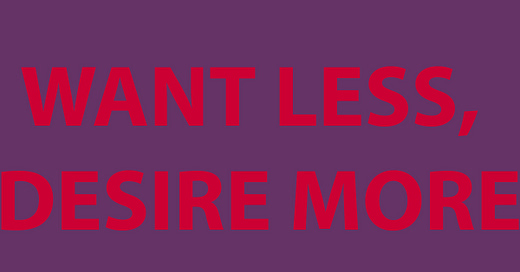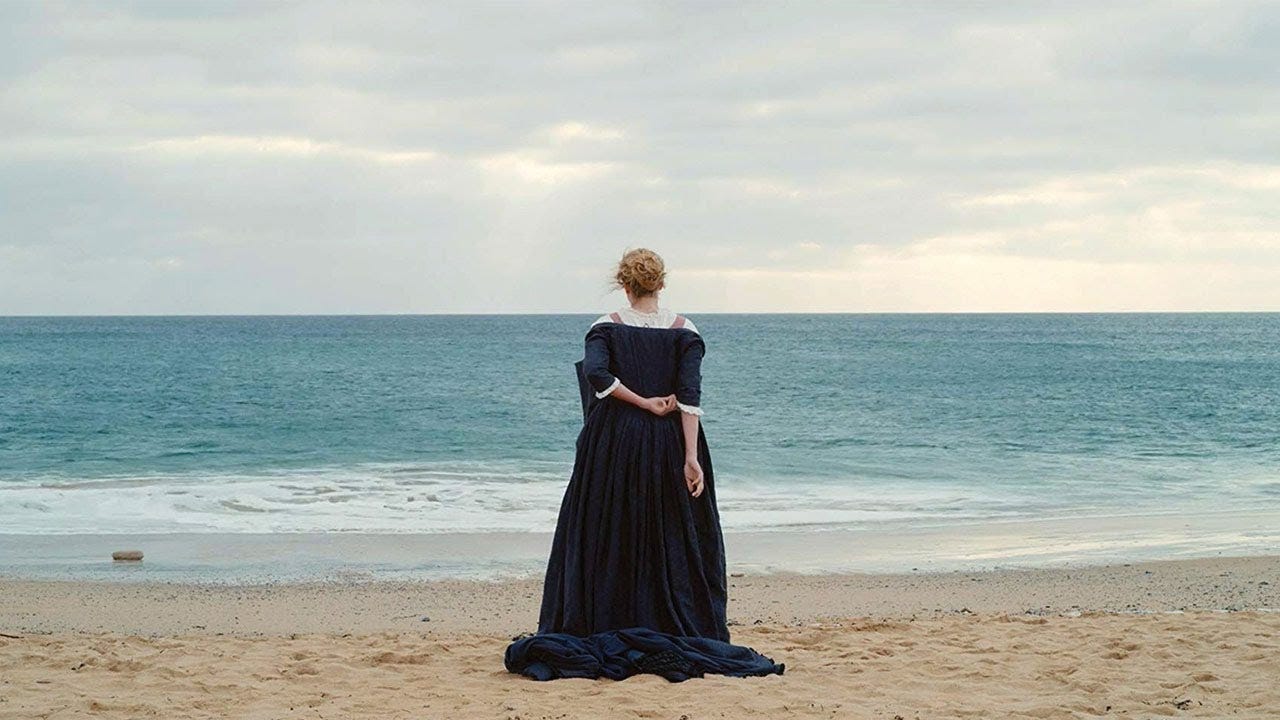How to Stoke Creative Desire
Struggling creatively? Try wanting less and desiring more. What we can learn from connecting to and working with desire in our personal and creative lives...
If you’re finding yourself struggling creatively — fielding disappointments or letdowns, navigating both real and imagined scarcity in your creative life, efforting too hard without the results you want, or just generally feeling foggy, unmotivated or adrift - may I propose you want less, but desire more?
In working with artists, I often find that when it comes to launching and realizing creative aspirations, we may actually be too stingy with our desires.
While action and strategy are important to moving a creative goal forward and to seeing our projects to fruition - I find that most creative people jump too quickly to strategy - “the how” - without getting clear on what they are really wanting - in fact, desiring. In getting clear on one’s creative desires, artists can reconnect to and feel motivated by a powerful felt-sense - one that they can return to throughout a creative process. In this way, desire acts like a generator - a feeling motor - that carries the artist forward with much less forcefulness or muscling through.
How do I tell the difference between wanting and desiring?
While wanting and desiring may be synonymous in the dictionary - I’m differentiating them here, approaching desire as something rooted to an inner drive, stirred from the inner life, and connected to life force energy. The Hebrew word tesuqah, now almost universally translated as "desire," was previously rendered as "turning" in the Old Testament. Desire is a turning in us.
Where does desire come from? How will I know it in myself?
One misconception that artists often carry is that we must rid ourselves of desire to create without ego. This notion may stem from misunderstandings of the differences between desiring and craving, clinging or attaching to external or material wants or outcomes. In fact, healthy desire, my meditation teacher used to say, is quite useful and important for motivating a person to meditate and to seek a greater level of awareness. We need desire to get us to the mat.
We need desire to create.
As part of a dominant culture that often disconnects us from desire — shaming us for our pleasure and longing while at the same time constantly producing and stoking want in us — we see you, capitalism — it can be confusing to figure out what genuinely gives us pleasure, and what we actually long for aka desire in a deeper sense.

The feminist theorist, Saba Mahmood, brilliantly describes how desire can be externally dictated and cued to the point that we then recognize and experience those externally-driven desires as “natural”, as our own, and can judge other peoples’ desires as out of the norm — she points out that, in fact, many of our so-called desires, and the behaviors connected to them, do not actually belong to us, and are not wholly from us. They are produced. Mahmood’s work argued for the value and integrity of women’s desires - specifically, in her work, around women of piety in the Middle East whose desires could be misconstrued as unnatural or coerced as seen through the lens of our liberal, Western norms. But, her work offers value to us, here - as she fought for the sovereignty and agency of women’s desires - allowing for all their unique forms and expressions. She saw desire as part of a larger creative movement that emphasizes and celebrates difference, and looked at all the ways our desires and behaviors can be both produced and natural.
For this reason, artists and creative people will benefit from centering desire in their creative work and lives, and beginning to explore it on their own terms. As we investigate and begin to work with (and from) a deep place of desire, we may begin to undo, or at least become more aware of some of our conditioning. Little by little, we may experience a “turning” - a returning to ourselves, to our motivations, preferences, pleasures and deeper longings - and as a result, we may feel ourselves more able to authentically direct both our creative impulses and our creative lives. Disconnected from our creative desires, we may find ourselves more often in a state of wanting, living out someone else’s desires for us, and even, carrying out someone else’s creative work in the world.
A NOT-SO-BEGINNER’S GUIDE TO STOKING DESIRE
People on Substack seem to like tips, so here are a few based on my work with artists, and from my own experiences!
Look To Your Pleasure
As desire and pleasure are intimately linked, spend some time following your nose — sniffing out, following and developing your unique sense of pleasure. Your simple pleasure can guide you back to yourself and towards a felt sense of desire. What activities, interactions, small daily rituals, spaces or places bring you pleasure? How can you bring yourself to these activities and spaces more often, and with this intention?
Listen To Your Body
Duh. Your body knows where pleasure and desire live in you. How can you listen to and build trust in your body’s cues. Where is an impulse or idea initiating from - the head, heart, solar plexus? Does this impulse or idea add heat and energy - or, does it drain you? Listening to our bodies is a learned practice, but over time - we can feel when our bodies are giving us a thumbs up, middle or down, and respond accordingly.
Begin With What You Don’t Want
Working with opposites can be a helpful practice to clarify our thinking and help us to relate to a quality or aspect that is harder to access or less familiar to us. Make a list of what you definitely do NOT desire - then look for the opposite. What do you hate? Now, look for is antecedent. This exercise is not to create a false binary but to use contrast to get more information.
Develop Your Tastes
The artist and facilitator, Liz Lerman, leads powerful work on the value of our aesthetics - and the origins of our personal preferences around what we find beautiful, pleasurable, interesting, worthwhile, and so on. Do some investigation on your own into where your tastes come from. Why do you like what you like? Who taught you so? Challenge your aesthetic values, while also working to hone and develop them in a deeper way.
Turn To The Erotic
Audre Lorde, bell hooks and many other authors and activists expound on the values and the power of the erotic, and its capacity to connect us to true feeling.
The erotic is a measure between the beginnings of our sense of self and the chaos of our strongest feelings. It is an internal sense of satisfaction to which, once we have experienced it, we know we can aspire. For having experienced the fullness of its depth of feeling and recognizing its power, in honor and self-respect we can require no less of ourselves.
[…]
Once we know the extent to which we are capable of feeling that sense of satisfaction and completion, we can observe which of our various life endeavors bring us closest to that fullness.
The aim of each thing we do is to make our lives and the lives of our children richer and more possible. Within the celebration of the erotic in all our endeavors, my work becomes a conscious decision—a longed-for bed, which I enter gracefully and from which I rise up empowered.—from Audre Lorde’s “Uses of the Erotic”
We can use our erotic capacities to begin to create intimacy, first with ourselves and then, with others. Desires are intimate - be they sexual desires, or the desires we hold for our creative life. Get quiet and listen inward to the desires stirring within. Whisper your heart’s desires to someone in your life and see what a vulnerable, intimate and powerful act that can be.
The erotic reminds us that we all deserve some satisfaction in our lives, and there is no shame in wanting, desiring, creative fulfillment for ourselves.
Where do you find a connection to the erotic - to an inviolable sense of your own inner power, to embodiment, to the intimate realm? It can be in sex, yes, but where else? How do you locate this feeling within, and make space for it in the world? How might this feeling drive you and show up in your creative work and life?
Finding this work valuable? Consider Sharing & Restacking so more people can access these creative resources.
WANT TO DIVE DEEPER?
LET’S APPLY THESE IDEAS DIRECTLY TO A CREATIVE PROJECT OR TO YOUR CREATIVE LIFE…
AN EXERCISE FOR CENTERING DESIRE IN ONE’S CREATIVE PRACTICE….
Keep reading with a 7-day free trial
Subscribe to THE CREATIVE SPRING! with Justine Wolf Williams to keep reading this post and get 7 days of free access to the full post archives.






